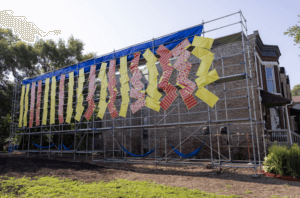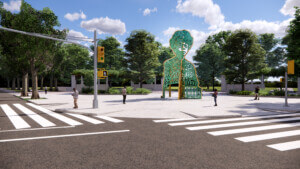As Jim Crow-era Confederate monuments continue to come down across the United States via toppling by protestors or planned, National Trust for Historic Preservation-supported removal efforts, calls for a seven-foot-tall bronze likeness of a man who left an indelible mark on the built environment in the greater New York City metro region to also be retired: Robert Moses.
Designed by Californian artist Jose I. Fernandez, the statue in question is a relatively recent one that was unveiled to considerable local fanfare in September 2003 on a quiet patch of grass on West Main Street next to Babylon Village Hall in Suffolk County, Long Island. The multiple title-holding urban planner, whose transformative infrastructural and housing projects of the mid-20th-century were underpinned with racism and a deep disdain for New York’s lower classes, was a resident of Babylon and died in the neighboring South Shore hamlet of West Islip in 1981. Since its debut, the statue, which was funded by the Babylon Village Public Arts Commission, has been met with mostly muted pushback—after all, Moses’ legacy is memorialized everywhere, from parks to bridges to roadways to schools and on. As such, a modest statue of Moses in his native stomping grounds didn’t generate much outrage at the time. Some places bearing his name, however, have seen been rename or have considered being renamed and some memorials, including a bust on Fordham University’s Lincoln Center campus in Manhattan, which only exists because Moses led the charge to displace a thriving Black and Latino community to make way for the urban renewal project, have since been removed.
Protestors in Babylon calling for the removal of the statue of Robert Moses on West Main Street @News12LI pic.twitter.com/py9YCeqXJI
— Logan Crawford (@LoganTCrawford) June 20, 2020
Now, amid an unprecedented social justice movement in support of Black causes, the Moses statue has come under increased scrutiny.
While many of the massive public works projects spearheaded by Moses were heralded at the time (Parks! Playgrounds! Affordable housing! Cultural centers! Modern parkways!) as the New York City region rebounded from the Great Depression, it wasn’t until the publication of Robert Caro’s 1974 biography The Power Broker that his deeply segregationist approach to urban planning came into full view.
A Change.org petition calling for the statue’s removal reads:
“A plaque included with statue contains exaggerated language glorifying Moses, saying that he had an ‘eye to the future’ and ‘preserved the integrity of the Long Island shoreline while creating a legacy for future generations.’ The true ‘future’ that Moses envisioned was divided and prejudiced. The plaque only mentions his injustices once, saying that he was a ‘dominant and sometimes controversial force.’ This statue clearly fails to adequately acknowledge his disregard for human lives for the sake of superficial innovation.”
Going on to note the aforementioned removal of the Moses bust at Fordham, the petition concludes: “We are asking that Babylon Village does the same, as the statue represents a long history of systemic racism and anti-Semitism.”
As of this writing, the petition has garnered over 13,700 signatures. Vanessa Cardino, who started the petition, also helped to organize a march in Babylon this past weekend. Per Newsday, which notes that over 100 protests have been held across Long Island in the weeks following the police-led killing of George Floyd in Minneapolis, the demonstration was attended by “nearly 100 people.”
“What we’re seeing in towns like mine—which again, because of the legacy of people like Robert Moses, is a very predominantly white community—is that you’re seeing that people have had enough of the current system of inequality of white supremacy,” Anthony Torres, an activist and Babylon resident who attended the rally, told Gothamist.
While New York City and environs have been otherwise quiet of the statue removal front, an equestrian sculpture of Theodore Roosevelt, which as the New York Times wrote, “has come to symbolize a painful legacy of colonial expansion and racial discrimination,” has been removed from the Central Park West entrance of the still-shuttered American Museum of Natural History.











